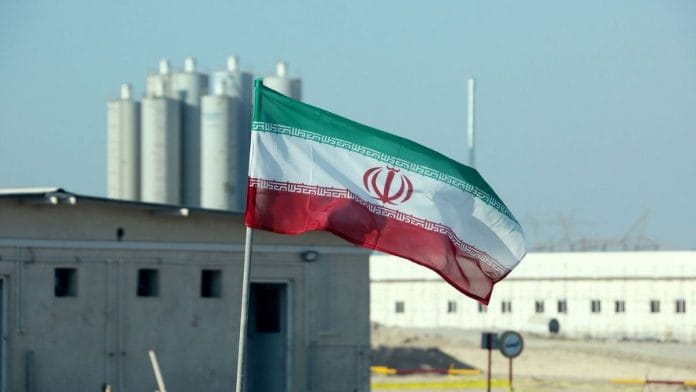In the end, it will all come down to hardliners in Washington and Tehran.
Months of indirect talks between the U.S. and Iran have failed to bring either country back into the Joint Comprehensive Plan of Action after Donald Trump, in one of the greatest own-goals of his presidency, withdrew from the pact in 2018 and imposed harsh sanctions on the Persian Gulf nation. Tehran responded by expanding its nuclear program in breach of the accord.
That there is no agreement — and no firm prospect of one before the self-imposed mid-February deadline — is making everyone nervous. Led by the five other world powers still party to the accord, China, France, Germany, Russia and the U.K., the talks intensified in January and are now in what negotiators describe as the final stage. A senior U.S. State Department official told a briefing Monday the process was entering “the end game.”
Iran wants sanctions lifted. The U.S. wants Tehran to walk back its advanced centrifuges and stockpiles. Then there are questions over the sequencing, the order in which each step will occur. If these can’t be resolved, the U.S. official said that the world would be facing “a reality of mounting tensions and crisis.” Even senior leaders in Israel, whose previous government had run a bitter campaign against the pact, “now regret the JCPOA withdrawal and call it a terrible mistake,” the official said.
Reviving the 2015 agreement is a high-stakes game. If it fails, Iran could be the next country to exit the 1968 Nuclear Nonproliferation Treaty, as North Korea did in 2003, said Ankit Panda, the Stanton Senior Fellow in the nuclear policy program at the Carnegie Endowment for International Peace. That would put at risk any progress on the development of a nuclear weapons free zone for the Middle East, he noted. (That’s aside from Israel, which, as the Stockholm International Peace Research Institute estimates in its 2021 report, has 90 nuclear weapons.) It could also prompt other countries, especially Saudi Arabia, to follow suit.
Since the U.S. withdrew from the deal, Iran has made significant leaps in its nuclear program — particularly over the last 12 months — including raising uranium enrichment to 60%, its highest level ever. Although there’s no evidence of weaponization, the breakout time (what it would take for Iran to produce enough weapons-grade enriched uranium fuel for a nuclear weapon) is now just a matter of weeks, as opposed to a year. It is impossible, Panda told me, to “unlearn” these advances. “This is knowledge that they have gained and can be used to further develop weapons.”
Even an interim pact, which some Iran watchers say has been proposed on the sidelines but is not a favored option, will need serious incentives to get hardliners in President Ebrahim Raisi’s regime to agree. That will involve allowing the nation, with the world’s No. 2 gas and No. 4 oil reserves, to return to international markets. A more difficult ask is Raisi’s demand for guarantees that a future U.S. administration won’t quit the deal as Trump did. This would be impossible for President Joe Biden to nail down with Iran hawks in his own party, let alone with Republicans.
Given Iran’s mastery of advanced centrifuges, the country would also need to dismantle the machines, “destroy the corresponding electronic infrastructure and mothball their assembly lines,” the International Crisis Group wrote in its Jan. 17 report on the talks. Tehran says these actions are beyond its JCPOA commitments.
U.S. sanctions under its “maximum pressure” posture have made life unbearable for Iranians, and a far cry from the “resistance economy” myth perpetuated by the regime. But while much had been made of the threat of Iran’s nuclear development to the U.S. and Israel, tensions in the wider region are also on the rise. In the third attack in a month, the United Arab Emirates on Monday intercepted a ballistic missile fired by Iran-backed Houthi fighters, further blowback from its involvement in the nearly seven-year war in Yemen. While the UAE has mostly exited the conflict, as did the U.S. last year, Saudi Arabia has continued its bombing campaign and has suffered rebel-led attacks on its oil installations.
Other Gulf states are escalating their diplomatic efforts in an attempt to push the deal closer to reality and patch up their own differences with Iran. Qatar’s ruler, Sheikh Tamim bin Hamad Al Thani, met Biden in the White House on Monday in the first visit of a Gulf Cooperation Council leader since he assumed the presidency. You’d hope the nuclear pact was on their agenda, along with Ukraine and Afghanistan. That follows a visit to Tehran on Jan. 27 by Qatar’s foreign minister, Mohammed bin Abdulrahman Al Thani, soon after his Iranian counterpart, Hossein Amirabdollahian, said Iran would consider direct negotiations with Washington if a “good deal” was on offer.
Iran’s Foreign Ministry spokesperson, Saeed Khatibzadeh, said Monday his government had presented negotiators in Vienna with a written initiative that could result in a “reliable, sustainable deal” if Washington agreed, according to the Islamic Republic News Agency.
But for now, negotiators have thrown the onus back on their political leaders for the next move. A failure to return to the accord will be a significant step backward in the push to stave off a nuclear arms race, which is a risk neither side can afford. As Sanam Vakil, deputy director and senior research fellow at Chatham House’s Middle East and North Africa program told me: “The U.S. and Iran are the main players in this drama — they need to talk.”
Let’s hope that happens, and that Biden and Raisi are able to win over their domestic audiences and re-enter the fold. We’ll all be a lot safer for it. – Bloomberg.
Also read: Kicking Russia out of Swift payment system could backfire






